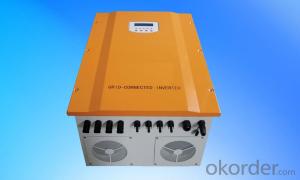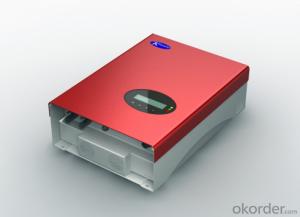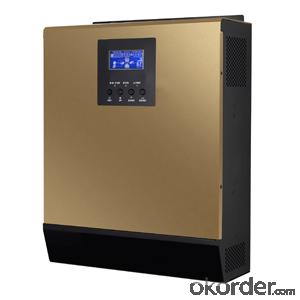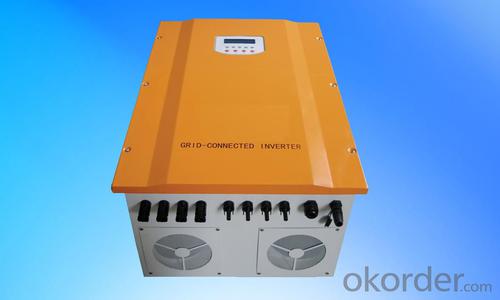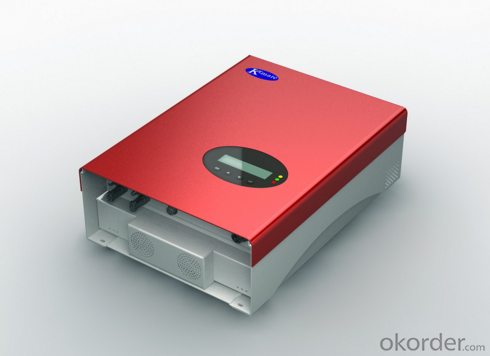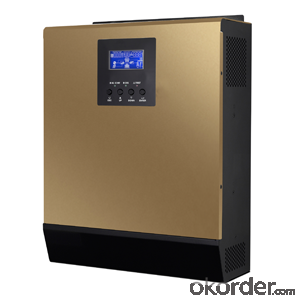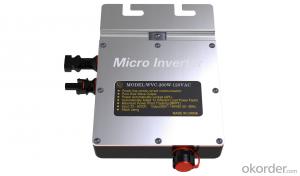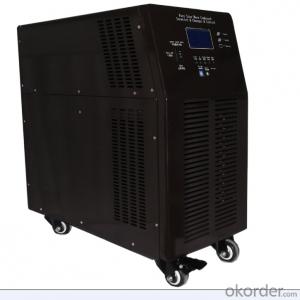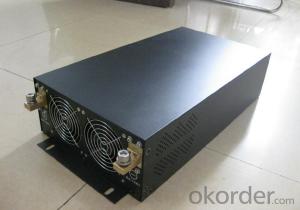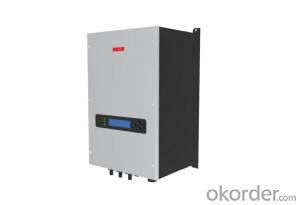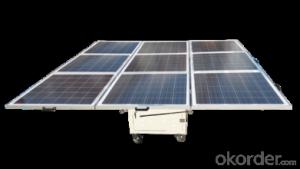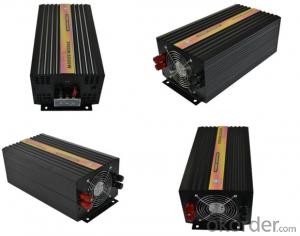Single Phase Inverter Second Generation 3.0k Solar Inverter made in China
- Loading Port:
- Shanghai
- Payment Terms:
- TT OR LC
- Min Order Qty:
- 0 watt
- Supply Capability:
- 10000 watt/month
OKorder Service Pledge
OKorder Financial Service
You Might Also Like
Description of Single Phase Inverter Second Generation 3k Solar Inverter
Solar ac power system consists of solar panels, charge controllers, inverter and battery; Solar energy does not include inverter dc power system. Inverter is a kind of power conversion device, inverter by incentives can be divided into self-excited oscillation inverter and separately excited oscillation inverter.
Features of Single Phase Inverter Second Generation 3k Solar Inverter
Standard 10 years warranty, 5-15 years optional
Built-in Gprs as option
Built-in Wifi as option
Smaller and lighter, only 9.6kg
High performance DSP for algorithm control
VDE-AR-N 4105 certification
New topology design
Dual MPPT design
Multi-button touch interface
LCD screen visible at night
Have anti-shading function
Advantages of Single Phase Inverter Second Generation 3k Solar Inverter
Longer life cycle
Plug and play
Free monitoring through our webportal
Very lower internal temperature
Easy transportation and installation
Faster CPU speed
Adjustable active and reactive power
Maximum conversion effciency up to 97.7%,Euro up to 97.0%
Real-time data readable at night
User friendly operation
Technical Data of Single Phase Inverter Second Generation 3k Solar Inverter
Type | Omniksol-3k-TL2-S |
Input(DC) | |
Max.PV Power | 3250W |
Max,DC Voltage | 500V |
Nominal DC Voltage | 360V |
Operating MPPT Voltage Range | 120-450V |
MPPT Voltage Range at Nominal Power | 150-450V |
Start up DC Voltage | 150V |
Turn off DC Voltage | 120V |
Max, DC Current | 18A/18A |
Max, Short Cicuit Current for each MPPT | 20A/20A |
Number of MPP trackers | 1 |
Number of DC Connection for each MPPT | 1 |
DC Connection Type | MC4 connector |
Output(AC) | |
Max,AC Apparent Power | 3000VA |
Nominal AC Power (cos phi = 1) | 3000W |
Nominal Grid Voltage | 220V/230V/240V |
Nominal Grid Frequency | 50Hz/60Hz |
Max, AC Current | 14.0A |
Grid Voltage Range* | 185-276V |
Grid Frequency Range* | 45-55Hz/55-65Hz |
Power Factor | 0.9 capacitive... 0.9 inductive |
Total Harmonic Distortion(THD) | <2% |
Feed in Starting Power | 30W |
Night time Power Consumption | <1W |
Standby Consumption | 6W |
AC Connection Type | Plug-in connertor |
Efficiency | |
Max,Efficiency | 97.7% |
Euro Efficiency | 97.0% |
MPPT Efficiency | 99.9% |
Safety and Protection | |
DC Insulation Monitoring | Yes |
DC Switch | Optional |
Residual Current Monitoring Unit (RCMU) | Integrated |
Grid Monitoring with Anti-islanding | Yes |
Protection Class | Ⅰ(According to IEC 62103) |
Overvoltage Category |
PVⅡ/Mains Ⅲ(According to IEC 62109-1)
|
Electricity Fuse Protection | Yes |
Reference Standard | |
Safety Standard | EN 62109, AS/NZS 3100 |
EMC Standard | EN 6100-6-1, EN 6100-6-2, EN 6100-6-3 EN 6100-6-4, EN 6100-3-2, EN 6100-3-3 |
Grid Standard | VDE-AR-N4105. VDE-0126-1-1,G83/1,EN 50438,RD1699,CEI 0-21, AS4777,C10/C11 |
Physical Structure | |
Dimensions | 343x281x150mm |
Weight | 9.9kg |
Environmental Protection Rating | IP 65 (According to IEC 60529) |
Cooling Concept | Internal fan convection |
Mounting Information | Wall bracke |
General Data | |
Operating Temperature Range | -25℃ to +60℃(derating above 45℃) |
Relative Humidity | 0% to 98%, no condensation |
Max. Altitude (above sea level) | 2000m |
Noise Type | <40dB |
Isolation Type | Transformerless |
Display | 3 LED ,Backlight, 4x20 Character LCD |
Data Communication | RS485(WiFi, GRPS integrated) |
Computer Communication | USB |
Standard Warranty | 10 Years (5-15 years optional) |
IMages of Single Phase Inverter Second Generation 3k Solar Inverter
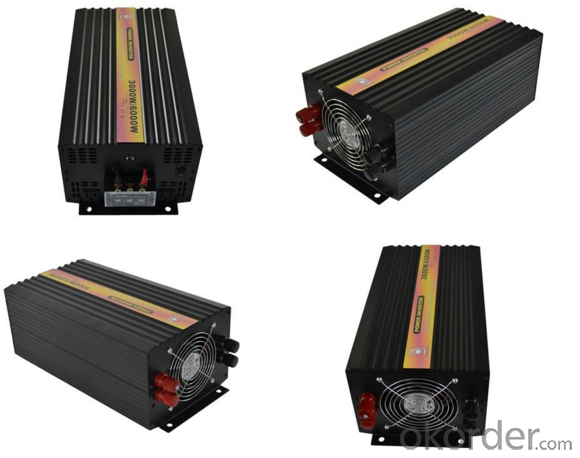
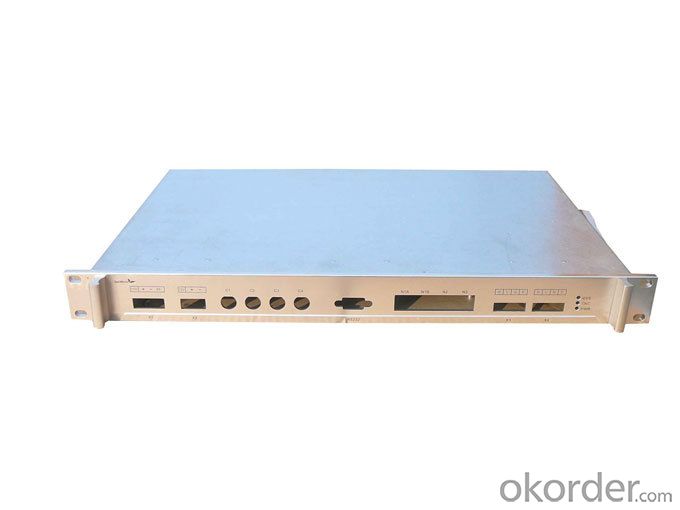
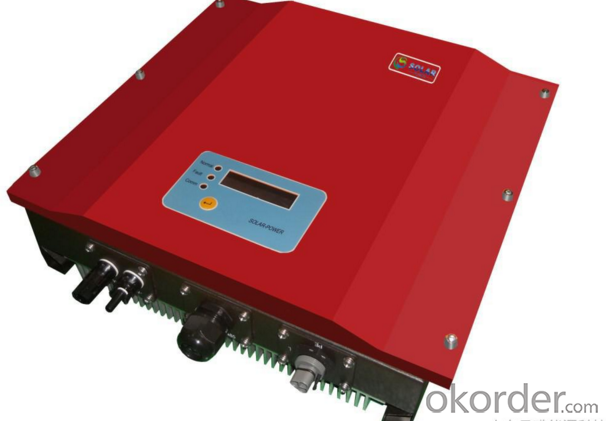
FAQ
Q: Do you have the CE, TUV, UL Certification?
A: We’ve already passed all the tests, and any certificate is available.
Q: Have you ever sold your products to companies in my country?
A: Of course, we have customers in all general PV markets, but I think we should expand our market share along with the market growth.
Q: When did your company set up? You are a new company, how can I believe your quality?
A: We entered into Solar PV industry in 2005, now we have several plants in manufacturing of a-Si and c-Si panels, and our capacity is 220MW per year. Till now we have already passed all the tests by authorized laboratories, e.g. TUV, CE, UL.
Q: Can you help us install the module if we cooperate with you?
A: We haven’t entered into installation sector, but we have the plan in near future.
Q: How do you pack your products?
A: We have rich experience on how to pack the panels to make sure the safety on shipment when it arrives at the destination.
Q: Can you do OEM for us?
A: Yes, we can.
Q: Can we visit your factory?
A: Surely, I will arrange the trip basing on your business schedule.
- Q: Can a solar inverter be used with solar trackers?
- Yes, a solar inverter can be used with solar trackers. Solar trackers are used to maximize the efficiency of solar panels by orienting them towards the sun. Solar inverters are responsible for converting the DC power generated by solar panels into usable AC power. Both components work together to optimize solar energy production.
- Q: What is the role of a power limiter in a solar inverter system?
- The role of a power limiter in a solar inverter system is to regulate the amount of power that is fed into the grid from the solar panels. Solar panels generate electricity based on the available sunlight, and at times, they may produce more power than what is needed or allowed by the grid. In such cases, a power limiter acts as a control mechanism to limit the amount of power that can be injected into the grid. It ensures that the power output from the solar panels remains within the specified limits, preventing overloading or destabilization of the grid. The power limiter continuously monitors the power output from the solar panels and adjusts it accordingly to match the grid requirements. It does this by intelligently controlling the inverter, which converts the direct current (DC) generated by the solar panels into alternating current (AC) suitable for grid integration. By limiting the power fed into the grid, a power limiter helps in maintaining grid stability, preventing voltage fluctuations, and minimizing the risk of power surges or blackouts. It also ensures compliance with local regulations and grid codes related to solar power generation. Additionally, a power limiter can provide additional functionalities such as grid synchronization, anti-islanding protection, and remote monitoring. These features enhance the safety, reliability, and overall performance of the solar inverter system. Overall, the presence of a power limiter in a solar inverter system is crucial for maintaining a balance between power generation and grid stability, optimizing the utilization of solar energy, and ensuring a safe and efficient integration of solar power into the electrical grid.
- Q: How does a solar inverter affect the overall system performance in different weather conditions?
- A solar inverter plays a crucial role in determining the overall system performance in different weather conditions. In situations with ample sunlight, a high-quality inverter optimizes the conversion of DC power generated by the solar panels into usable AC power. This ensures maximum energy output and efficient utilization of solar energy. However, in adverse weather conditions like cloudy or overcast skies, a good inverter can still extract a significant amount of power by employing advanced MPPT algorithms and voltage regulation techniques. It helps maintain system stability and mitigates power losses, thereby minimizing the impact of weather conditions on the overall system performance.
- Q: The function of photovoltaic grid - connected inverter
- By dc / dc conversion to increase or decrease the input voltage, adjust its output to achieve maximum efficiency.
- Q: What is the efficiency loss of a solar inverter over time?
- The efficiency loss of a solar inverter over time can vary depending on various factors such as the quality of the inverter, maintenance practices, and environmental conditions. Generally, solar inverters experience a gradual decrease in efficiency over their lifespan. On average, the efficiency loss can range from 0.5% to 1% per year. However, regular maintenance and monitoring can help minimize this loss and ensure optimal performance.
- Q: What is the role of a solar inverter in a community solar project?
- The role of a solar inverter in a community solar project is to convert the direct current (DC) electricity produced by solar panels into alternating current (AC) electricity that can be used by homes and businesses in the community. It ensures that the solar energy generated is compatible with the existing electrical grid, allowing for seamless integration and distribution of clean energy to the community.
- Q: Can a solar inverter be used in conjunction with a generator?
- Yes, a solar inverter can be used in conjunction with a generator. In fact, it is a common setup in hybrid systems where the solar panels generate electricity during the day, and the generator provides power during periods of low solar production or high energy demand. The solar inverter converts the DC power from the solar panels and the AC power from the generator into a usable form for the connected appliances and the grid. This combination allows for a more reliable and efficient power supply.
- Q: How does a solar inverter communicate with monitoring systems?
- A solar inverter communicates with monitoring systems through various communication protocols such as Wi-Fi, Ethernet, or cellular networks. These protocols allow the inverter to send real-time data regarding the system's performance, including power output, voltage, and current, to the monitoring system. This data is then analyzed and displayed on a monitoring platform or app, providing insights into the solar system's overall efficiency, energy production, and any potential issues or faults.
- Q: In a photovoltaic grid-connected project, the role of the inverter is to convert the voltage into AC 220V or 380V for the grid, since the transformer will raise the voltage again
- Part of the distributed grid-connected projects, the basic are "spontaneous use, the power of the Internet," these do not need to boost, because the extra power is actually consumed by the surrounding electricity users, do not boost to a Level power grid;
- Q: What is the maximum output voltage of a solar inverter?
- The maximum output voltage of a solar inverter depends on various factors such as the inverter model, design, and specifications. However, in general, the maximum output voltage of a solar inverter is typically around 230-240 volts for residential or commercial applications.
Send your message to us
Single Phase Inverter Second Generation 3.0k Solar Inverter made in China
- Loading Port:
- Shanghai
- Payment Terms:
- TT OR LC
- Min Order Qty:
- 0 watt
- Supply Capability:
- 10000 watt/month
OKorder Service Pledge
OKorder Financial Service
Similar products
Hot products
Hot Searches
Related keywords
